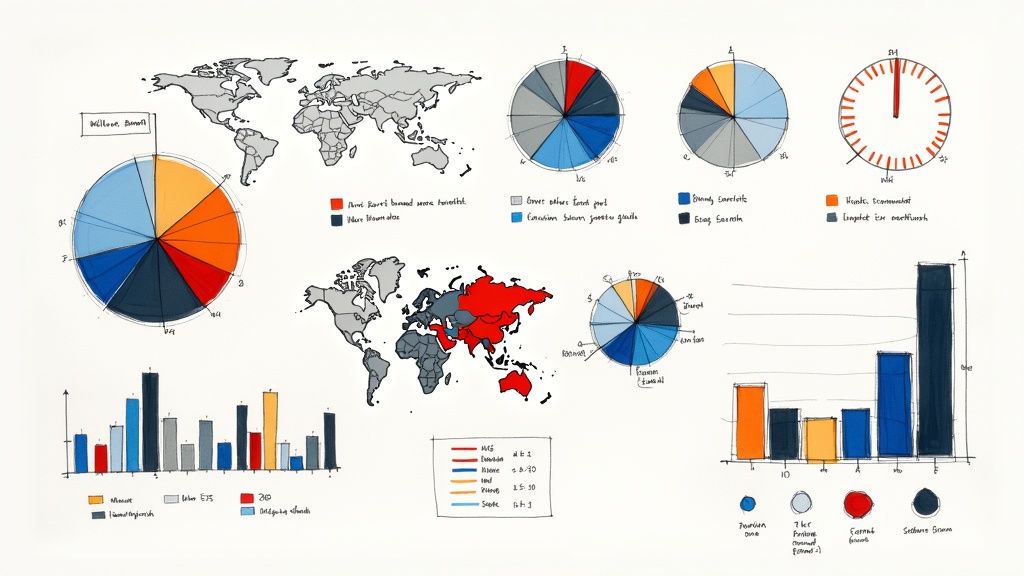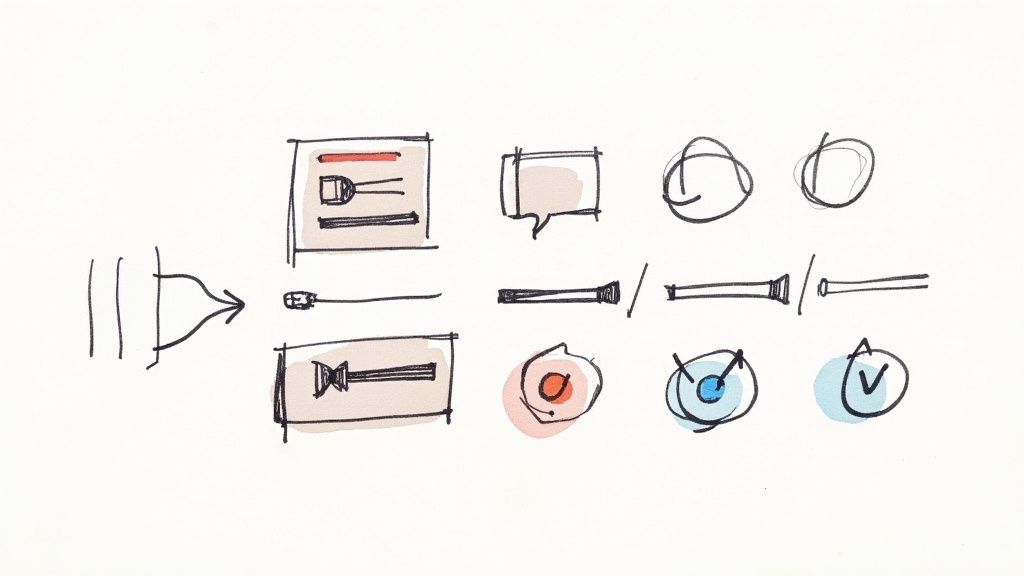Top Content Repurposing Strategies to Boost Reach in 2026

In today's saturated media environment, creating high-quality content is only the first step.
The critical second step is ensuring that content reaches its maximum potential audience across multiple channels. This is where mastering effective content repurposing strategies becomes a game-changer.
It's not about recycling old material. It's a strategic process of transforming a single, high-effort piece into a diverse portfolio of assets tailored for different platforms, formats, and audience preferences.
Why Content Repurposing Matters for Authors
By implementing this approach, authors and marketers can save countless hours, amplify their core message, and solidify their authority. This isn't just about efficiency—it's about extending the lifespan and impact of every blog post, book chapter, or podcast episode you produce.
For authors specifically, effective repurposing transforms your manuscript into a complete book marketing ecosystem that works across every channel your readers inhabit.
This guide moves beyond generic advice to provide a deep dive into specific, actionable techniques. We will explore how to atomize long-form articles, transform static text into engaging visuals, and turn behind-the-scenes material into compelling marketing tools. You will learn practical methods to work smarter, not harder, turning each core piece of content into a perpetual engine for audience growth and engagement. Let's get started.
1. Long-Form to Short-Form Content Atomization
Content atomization is the process of deconstructing a large, foundational piece of content into numerous smaller, highly focused assets. This is one of the most powerful and efficient content repurposing strategies because it allows you to maximize the reach and impact of your most significant content investments, such as a comprehensive book, an in-depth webinar, or a detailed podcast episode. Instead of a single touchpoint, you create a whole ecosystem of content that caters to different platforms and audience preferences.
This approach ensures your core message reaches audiences who prefer quick, digestible formats. For example, a detailed chapter from your book on marketing techniques can be broken down into a series of short video tips for TikTok, a compelling Twitter thread, a visually appealing infographic for Pinterest, and a practical checklist for your email subscribers. This multiplies your visibility without requiring you to reinvent the wheel.

How to Implement Content Atomization
Successfully atomizing content requires a strategic plan, not just random slicing and dicing. Start by identifying the "pillar" content that holds the most value. For an author, this is often the book itself or a keynote speech about its central themes.
From there, map out potential micro-content pieces. A single chapter could yield:
- Quote Graphics: Pull out impactful sentences for visually engaging posts on Instagram or Facebook.
- Short-Form Videos: Record yourself explaining a key concept from the chapter in a 60-second video for Reels or YouTube Shorts.
- Blog Posts: Expand on a specific anecdote or data point from the chapter, adding new context and a call-to-action to buy the book.
- LinkedIn Articles: Adapt a professional or business-oriented section into a thought leadership article for your industry peers.
Always tailor the atomized piece to the platform. What works as a professional article on LinkedIn will need a different tone and format for a casual, fast-paced platform like TikTok.
2. Cross-Platform Format Transformation
Cross-platform format transformation is a nuanced strategy that goes beyond simply copying and pasting content across different channels. It involves thoughtfully adapting a core piece of content to fit the specific requirements, user expectations, and consumption patterns of each platform. This is one of the most effective content repurposing strategies because it respects the unique culture of each social media site or content hub, ensuring your message lands with maximum impact.
Instead of a one-size-fits-all approach, this method treats each platform as its own distinct medium. For example, a detailed blog post from an author about their research process can be transformed into a visually driven Instagram carousel with key photos and takeaways, a professional and insightful LinkedIn article, and a fast-paced, engaging Twitter thread with a hook. This ensures the content feels native to the platform, boosting engagement and resonance with each unique audience.

How to Implement Cross-Platform Transformation
Successful transformation requires a deep understanding of what works where. Begin by selecting a core content asset, like an in-depth podcast interview or a chapter from your book, and then brainstorm how its essence can be translated into different formats.
Consider adapting a single webinar into these distinct assets:
- YouTube Video: Edit the webinar into a polished, 10-15 minute "best of" video, complete with on-screen graphics and chapter markers.
- Instagram Reels: Create several short, punchy videos from the most compelling 30-60 second clips, adding trending audio and text overlays.
- Podcast Episode: Release the full audio from the webinar as a standalone podcast episode for audiences who prefer listening on the go.
- Twitter Thread: Distill the webinar’s key learning points into a concise, numbered thread that encourages discussion and sharing.
Always maintain your core brand voice while adapting the tone and style to the platform's culture. For authors, understanding the nuances of social media marketing is crucial for success. Our Market My Book service automates social media content creation tailored to each platform's unique requirements, saving you hours of manual adaptation.
Subscribe & Get Your Free Marketing Plan Template
Receive regular updates on marketing best-practices, AI shortcuts, and get our proven 4-phase marketing roadmap for free.
Unsubscribe anytime.
3. Seasonal and Evergreen Content Cycling
This strategy involves strategically reusing and updating your best content based on seasonal relevance or its enduring, evergreen value. It is one of the most sustainable content repurposing strategies because it maximizes the lifespan of your work by bringing it back into circulation when audiences need it most. Instead of letting valuable assets gather dust, you refresh them to capture timely interest year after year.
For an author, this means that a blog post about writing a novel for NaNoWriMo (National Novel Writing Month) can be updated and re-promoted every November. Similarly, content about setting writing goals is perfect for a New Year's campaign. This keeps your brand relevant and demonstrates your expertise on a consistent, predictable schedule.

How to Implement Content Cycling
Effective content cycling starts with a content audit to identify your high-performing seasonal and evergreen pieces. Companies like TurboTax have mastered this by updating their core tax preparation guides annually for new regulations, while outdoor retailer REI republishes its hiking guides each spring with the latest gear.
Follow these steps to cycle your content successfully:
- Create a Content Calendar: Map out key dates, holidays, or seasons relevant to your book's topic. For a mystery writer, this could be Halloween; for a romance author, Valentine's Day.
- Refresh and Update: Before republishing, update any statistics, links, or examples. Add new insights or connect the content to current events to give it a fresh feel.
- Promote Anew: Don't just hit "publish." Promote the updated content as if it were brand new across your email list, social media, and other channels. Announce the "2024 Edition" of your popular guide.
- Track Performance: Use a spreadsheet to monitor the performance of your cycled content. This helps you refine your strategy and know which pieces deliver the best results over time.
4. User-Generated Content Integration
User-Generated Content (UGC) Integration is a powerful strategy that involves curating authentic content created by your audience and repurposing it across your own marketing channels. This approach transforms customers, fans, and community members into active participants in your brand narrative. By leveraging their photos, videos, reviews, and stories, you can build powerful social proof and foster a deeper sense of community, all while reducing your own content creation workload.
This is one of the most effective content repurposing strategies because it places authenticity at the forefront. For an author, this could mean turning reader-submitted photos with your book into a social media campaign, or transforming heartfelt reviews into compelling testimonials for your website. Brands like Starbucks have mastered this with their #RedCupContest, turning customer photos into a viral marketing asset across social media and even in-store displays.

How to Implement User-Generated Content Integration
A successful UGC strategy is built on clear communication and mutual respect. Start by creating a dedicated hashtag that encourages your readers or customers to share their experiences with your product, such as #MyAuthorJourney or #[YourBookTitle]InTheWild. This makes it easy to find and collate submissions.
From there, you can repurpose this content in various ways:
- Social Media Campaigns: Feature the best user photos or videos on your Instagram, Facebook, or TikTok feed, always tagging and crediting the original creator.
- Website Testimonials: Transform positive reviews from Goodreads or Amazon into visually appealing graphics for your book's sales page.
- Email Newsletters: Create a "Reader of the Week" or "Community Spotlight" section in your newsletter showcasing how others are engaging with your work.
- Blog Content: Compile a roundup post of the most creative UGC, such as "10 Amazing Places Our Readers Took Our Book."
Crucially, always request explicit permission before repurposing someone's content. A simple direct message asking for their consent is usually sufficient and demonstrates respect for your community.
5. Educational Content Series Development
Developing an educational content series involves transforming a single, comprehensive educational piece into a structured, multi-part course. This is one of the most effective content repurposing strategies for establishing authority and keeping your audience engaged over time. Instead of a one-off guide or video, you create a sequential learning path that breaks down complex topics into digestible installments, guiding users from one concept to the next.
This strategy nurtures your audience by providing consistent, high-value information. For example, a single chapter on character development from a writing guide can be repurposed into a multi-week email course, a series of short tutorial videos, and a sequence of blog posts. This drip-feed approach builds anticipation and transforms a one-time reader into a loyal follower who eagerly awaits the next piece of content.
How to Implement an Educational Content Series
A successful series requires careful planning and a clear roadmap. Start by outlining the entire learning journey, from the foundational concepts to the advanced takeaways. For an author, this could be based on the core methodology presented in their non-fiction book.
From this high-level outline, you can create the individual components of the series:
- Create a Master Outline: Plan the entire series structure before creating any individual pieces to ensure a logical flow and consistent narrative.
- Establish Series Branding: Use consistent visual elements, titles, and formats to make the series instantly recognizable across platforms like your blog, YouTube, and social media.
- Build-in Progression: Each piece should stand alone as valuable but also clearly connect to the previous installment and tease the next one. Include clear calls-to-action to guide the audience to the next part.
- Offer a Capstone Resource: At the end of the series, repurpose all the content into a comprehensive downloadable resource like a complete guide or workbook. For a deeper dive into creating this type of content, you can learn more about developing a blog series on manuscriptreport.com.
6. Behind-the-Scenes Content Expansion
Behind-the-scenes (BTS) content expansion is a strategy that transforms your internal processes, team activities, and company culture into authentic public-facing assets. This is one of the more unique content repurposing strategies because it taps into a resource you're already creating every day: your work. Instead of hiding the "how," you document and share it to humanize your brand, build trust, and provide genuine value.
This approach gives your audience a privileged look into your operations, making them feel more connected to your brand. For instance, documenting the messy, iterative process of developing a new product, like Ben & Jerry's does with its flavor creation, can be repurposed into a captivating blog series, a series of Instagram Stories, and short-form videos. This transparency builds a loyal community that is invested in your journey, not just your final product.
How to Implement Behind-the-Scenes Content Expansion
Successfully expanding on BTS content means identifying what is interesting to an outside audience and packaging it professionally. Start by auditing your daily and weekly operations. What recurring meetings, creative sessions, or problem-solving discussions could offer value or entertainment?
From there, you can create a content pipeline from these moments:
- Process Documentation: Record a screen-share of your design team's workflow or a writer's research process. This can be edited into a tutorial video for YouTube, a detailed blog post, and a series of "pro-tip" graphics for LinkedIn.
- Team Culture Moments: Capture snippets from team-building events, brainstorming sessions, or even fun Slack conversations. These can be repurposed into Instagram Reels, company culture blog posts, or recruiting materials.
- Project Timelines: Document the lifecycle of a major project, from initial concept to final launch. Turn this journey into a compelling case study, a series of update posts on social media, or a webinar detailing the lessons learned.
- Q&A Sessions: Host an internal Q&A with a team lead and repurpose the answers into an "Ask Me Anything" blog post, short video clips for social media, and a downloadable FAQ sheet.
Always get consent from team members before featuring them and establish clear guidelines to maintain a balance between authenticity and professionalism. The goal is to offer a genuine peek behind the curtain, not an unstructured data dump.
7. Data Visualization and Infographic Repurposing
This strategy transforms complex data, research findings, and statistics into visually appealing and easily shareable assets. It’s one of the most effective content repurposing strategies for making dense information accessible and engaging. Instead of presenting readers with a wall of text or a complicated spreadsheet, you convert key insights into infographics, charts, and other visual formats that are quick to understand and hard to ignore.
This approach is invaluable for authors whose books are built on research, surveys, or extensive data analysis. Organizations like the Pew Research Center and companies like Salesforce excel at this, turning comprehensive reports into a suite of visual content. For example, a single data point from a sales report can become a compelling social media graphic, a key slide in a presentation, or a section within a larger infographic, amplifying the reach of the original research.
How to Implement Data Visualization Repurposing
The goal is to distill complex information into a clear, visually compelling narrative. Start by identifying the most surprising, impactful, or counterintuitive data points from your book or research. These will form the core of your visual assets.
From a single research chapter or report, you can generate:
- Standalone Infographics: Create a comprehensive infographic that summarizes the key findings of your entire study. This serves as a powerful, standalone piece of content for your blog or for guest posts.
- Social Media Charts: Isolate a single, powerful statistic and create a simple, branded chart or graph for platforms like LinkedIn, Twitter, or Instagram. Spotify's "Wrapped" campaign is a masterclass in turning personal data into shareable social graphics.
- Interactive Data Tools: For more complex datasets, consider creating a simple interactive tool on your website that allows users to explore the data themselves, increasing engagement and time on site.
- Presentation Slides: Convert key charts and data points into a slide deck that can be used for webinars, conference presentations, or as a downloadable lead magnet.
Always prioritize clarity and brand consistency. Use a consistent color scheme and font, and clearly cite your data source (your book!) to drive traffic and establish authority.
8. Interactive Content Transformation
Interactive content transformation involves converting static assets like articles, reports, or guides into engaging, hands-on experiences. This is one of the more advanced content repurposing strategies because it shifts the audience from passive consumption to active participation. Instead of just reading information, users interact with it, creating a more memorable and personalized journey.
This strategy excels at boosting engagement and capturing valuable user data. For example, a blog post detailing "10 Steps to Financial Freedom" can be transformed into an interactive quiz that helps users identify their financial weak spots. The results not only provide immediate value to the user but also generate new content, such as social media posts highlighting common quiz outcomes or email campaigns targeted based on user responses.
How to Implement Interactive Content Transformation
The key to this strategy is to identify content that can be gamified or personalized. Look for your most popular blog posts, guides, or data-heavy reports, as these are prime candidates for an interactive makeover.
From there, choose an interactive format that aligns with your original content's goal:
- Quizzes and Assessments: Convert a "how-to" guide or listicle into a quiz. BuzzFeed perfected this model, turning simple personality traits into shareable "Which character are you?" quizzes.
- Calculators and Generators: Turn data-driven content or instructional guides into practical tools. Shopify’s business name generator is a classic example, taking the concept of "how to name a business" and turning it into an interactive tool that captures leads.
- Interactive Infographics or Maps: Adapt a static infographic with complex data into a clickable, explorable experience where users can uncover insights on their own.
Start with simple tools before investing in complex platforms. Most importantly, design the experience to produce shareable results, encouraging users to distribute your content for you.
9. Podcast and Audio Content Multi-Channel Distribution
Multi-channel distribution transforms your podcast, interview, or any audio recording into a wide array of content assets. This strategy is one of the most effective content repurposing strategies for creators who rely on audio, as it extends the life and reach of a single recording across multiple platforms. Instead of your insights being confined to an audio-only format, you can engage audiences on visual and text-based channels, capturing attention from users with different consumption habits.
This approach capitalizes on the depth and authenticity of spoken-word content. For example, a 45-minute podcast interview with an author can be transcribed and reshaped into a detailed blog post, its most compelling soundbites can become audiogram clips for Instagram, and powerful quotes can be turned into visually striking graphics for LinkedIn or Twitter. This maximizes the value of the original conversation and drives traffic back to the full episode.
How to Implement Audio Multi-Channel Distribution
A strategic workflow is key to effectively repurposing audio content. Start by identifying the most valuable segments of your recording, such as profound insights, actionable tips, or memorable anecdotes. These are the goldmines you will build your repurposed assets around.
From a single podcast episode, you can generate:
- Full Transcription: Post a full transcript on your website as a blog post. This makes your content accessible and significantly improves SEO by making the spoken words indexable by search engines.
- Audiograms: Use tools to create short video clips that combine a static image, a waveform animation, and an audio snippet. These are perfect for sharing on social media platforms like Instagram and LinkedIn to tease the full episode.
- Quote Graphics: Isolate powerful quotes from your guest or yourself and design them into shareable images. This is a simple yet highly effective way to spread key messages visually.
- Blog Posts & Articles: Expand on a specific topic discussed in the podcast. Use the transcript as a base to write a more structured, in-depth article, adding research and context. This is an excellent tactic for promoting a book or a specific product. Learn more about how this can fit into a larger promotional plan in our comprehensive guide on how to promote your book.
Always ensure the repurposed content feels native to its new platform. A formal insight shared on LinkedIn should have a different presentation than a quick, engaging tip shared on TikTok.
Content Repurposing Strategies Comparison
| Strategy | Implementation Complexity 🔄 | Resource Requirements ⚡ | Expected Outcomes 📊 | Ideal Use Cases 💡 | Key Advantages ⭐ |
|---|---|---|---|---|---|
| Long-Form to Short-Form Content Atomization | Medium - requires initial setup and organization | Moderate - content management and repurposing tools | Increased content volume and audience reach | Maximizing ROI on long-form content, multi-platform distribution | Maximizes content ROI, improves SEO, varied audience reach |
| Cross-Platform Format Transformation | High - deep platform knowledge needed | High - time and expertise for adaptation | Broad audience engagement and brand visibility | Brands targeting diverse audiences on multiple platforms | Leverages platform algorithms, tailored messaging |
| Seasonal and Evergreen Content Cycling | Medium - requires organized content audits | Moderate - content management and updating | Prolonged content lifespan and consistent relevance | Businesses with seasonal trends, evergreen content needs | Extends content ROI, reduces creation pressure |
| User-Generated Content Integration | Medium - ongoing community management | Low to Moderate - managing submissions | Authentic engagement and trust building | Community-focused brands, social proof marketing | Builds trust, lowers content costs, diverse perspectives |
| Educational Content Series Development | High - extensive planning and research | High - content creation across formats | Established thought leadership and deep engagement | B2B, SaaS, educational organizations | Establishes expertise, drives repeat audience engagement |
| Behind-the-Scenes Content Expansion | Low to Medium - depends on team cooperation | Low - uses existing internal activities | Enhanced brand personality and emotional connection | Brands aiming for authenticity and transparency | Builds trust, low resource demand, emotional connection |
| Data Visualization and Infographic Repurposing | Medium to High - requires design expertise | Moderate to High - design tools and skills | Improved engagement with complex data | Data-heavy reports, research dissemination | Makes data accessible, increases shareability |
| Interactive Content Transformation | High - requires technical development | High - development and maintenance resources | Increased engagement and valuable user data | Brands seeking active user participation and experiential marketing | Boosts engagement, generates insights, shareable content |
| Podcast and Audio Content Multi-Channel Distribution | Medium - transcription and editing needed | Moderate - transcription tools and editing | Expanded reach across formats and SEO benefits | Audio content producers wanting multi-format presence | Increases accessibility, multiplatform reach, SEO gains |
From Creation to Amplification: Making Repurposing Your Default
The nine content repurposing strategies detailed throughout this article represent a crucial evolution in how we approach marketing and audience engagement. Moving beyond the exhausting "create, publish, repeat" cycle, these methods champion a more sustainable and powerful philosophy: a strategic system of amplification. By embedding repurposing into your core workflow, you transform every piece of content from a single, isolated event into a versatile asset with a vastly extended lifespan and reach.
This approach isn't just about saving time; it's about maximizing impact. You build a more resilient and far-reaching brand presence that doesn't solely depend on your ability to produce something entirely new every single day. The true value lies in creating a content ecosystem where each element supports and elevates the others, ensuring your message consistently reaches new audiences in the formats they prefer.
Key Takeaways and Your Path Forward
Recapping the core ideas, we see a clear path from a single piece of content to a multi-channel campaign.
- Deconstruction is Key: The principle behind atomizing long-form content, transforming educational series, and pulling from behind-the-scenes footage is deconstruction. Breaking down large assets into smaller, digestible pieces is the foundation of many powerful content repurposing strategies.
- Format Fluidity: Success requires thinking beyond the original format. Transforming written content into visuals like infographics, turning data into interactive quizzes, or adapting blog posts into podcast segments ensures you meet your audience where they are.
- Strategic Cycling: Not all content needs to be new. Refreshing evergreen articles and strategically re-promoting seasonal content keeps your best work in front of your audience, continuously delivering value without starting from scratch.
For authors, publishers, and marketers in the literary world, these principles are particularly potent. A single manuscript is not just a book; it's a treasure trove of potential blog posts, social media snippets, podcast episodes, infographics, and email courses. These strategies integrate seamlessly with your overall book marketing plan to create a cohesive, multi-channel approach.
Your Actionable Next Steps
Feeling overwhelmed by the possibilities is natural. The key is to start small and build momentum. Do not attempt to implement all nine strategies at once. Instead, take a methodical approach to integrate content repurposing into your routine.
- Conduct a Content Audit: Begin by reviewing your existing assets. Identify your "pillar" content, such as a comprehensive guide, a popular webinar, a data-rich report, or even a book manuscript. Which pieces have performed the best or contain the most valuable information?
- Select One Strategy: Choose a single repurposing tactic that aligns with your strongest pillar content and available resources. If you have a successful podcast, focus on multi-channel audio distribution and creating audiograms. If you have a detailed blog post, start by turning its key statistics into a shareable infographic.
- Document Your Process: As you execute your first repurposing project, document every step. Create a simple checklist or template. This documentation will make it exponentially easier to repeat the process, delegate it to team members, and build a scalable system.
By starting with one focused effort, you can master the workflow, measure the results, and gain the confidence to expand your approach. You will transform your content library from a static archive into a dynamic engine that consistently drives engagement, authority, and growth. Embrace this mindset, and you'll find that the potential for your existing content is truly limitless.
Frequently Asked Questions About Content Repurposing Strategies
Conclusion: Turn Your Book Into a Marketing Powerhouse
Ready to identify the most potent, repurposable content from your book before you even publish? The powerful AI analysis from ManuscriptReport.com can instantly break down your manuscript, identifying key themes, character arcs, and marketable quotes that are perfect for creating a dynamic content campaign.
Resources to Maximize Your Repurposing Strategy
Enhance your content repurposing efforts with these specialized services and guides:
- Manuscript Report - AI-powered analysis identifying repurposable content from your manuscript
- Market My Book - Automated social media content across multiple platforms
- Blog Series Service - Transform your book into a complete blog content series
- Book Marketing Services - Comprehensive marketing support with repurposing strategies
- Book Marketing Strategies Guide - Complete marketing playbook for authors
- Effective Ads for Indie Authors - Repurposing content for paid advertising
Get your comprehensive marketing report at ManuscriptReport.com and turn your book into a marketing powerhouse from day one.
Trusted by 1,000+ authors. Starting from only $25. Transform one manuscript into months of marketing content.
Enjoyed this article? Subscribe for more + get a free marketing roadmap template.
Receive regular updates on marketing best-practices, AI shortcuts, and get our proven 4-phase marketing roadmap template for free.
Unsubscribe anytime.